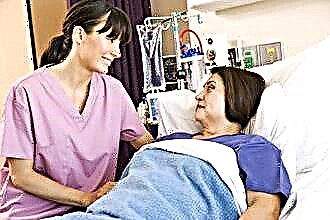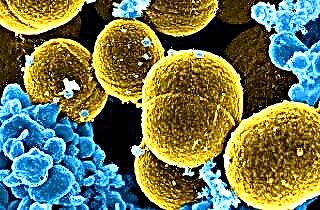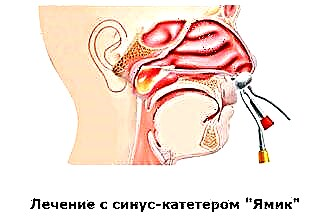Each of us has come across such an unpleasant condition as a sore throat. She may be disturbed when talking, eating, or when calm. Pain is especially common during cold weather, but on hot days there is also a risk of getting sick. What to do if your throat hurts badly?
 Methods of dealing with pain syndrome depend on the causes of its occurrence. Among the provoking factors, it is worth noting:
Methods of dealing with pain syndrome depend on the causes of its occurrence. Among the provoking factors, it is worth noting:
- a viral lesion of the mucous membrane of the oropharynx, in which, in addition to pain, nasal congestion, rhinorrhea, malaise, aching muscles, joints, while the temperature does not rise above 37.5 degrees, may disturb.
- activation of bacterial pathogens, for example, streptococcus, when there is severe sore throat, febrile hyperthermia and severe intoxication syndrome.
- fungal infection, which in most cases develops with prolonged use of antibacterial agents.
- environmental factors such as cold, dusty air, smoke, which irritate the mucous membrane of the pharynx and predispose it to injury. In turn, the violation of the integrity of the protective barrier increases the risk of infection.
- strong tension of the vocal cords, when microcracks appear on the mucous membrane of the oropharynx.
- proliferation of thyroid gland tissues, which squeeze nerve fibers, provoking the appearance of pain syndrome. However, the patient may also be disturbed by an increase / decrease in heart rate, fluctuations in body weight, exophthalmos, menstrual dysfunction and changes in the psychoemotional state.
- a traumatic factor, for example, the use of crackers, can cause pain due to a violation of the integrity of the mucous membrane. As for a burn with alkali or acid, urgent medical attention is needed, as well as a diagnosis of the depth and area of the lesion.
- allergic agents such as wool, pollen, fluff, which causes irritation of the mucous membrane.
Therapeutic tactics
To begin to treat severe sore throat should be with the elimination of the provoking factor. This applies to the rest of the vocal cords when they are overstrained, the lack of contact with allergens and the fight against infectious pathogens.
Treatment areas include:
- reduction of tissue edema, hyperemia and soreness;
- increased local immune defense;
- elimination of pathogenic microorganisms.
Systemic infection control
When general signs of the disease appear, such as hyperthermia, body aches, malaise, it is worth suspecting the spread of infection from the place of its introduction throughout the body. To prevent the formation of infectious foci in organs, the development of severe complications associated with organ dysfunction, the doctor prescribes complex treatment.
If a viral disease is diagnosed, it is recommended to take antiviral drugs:
- Arbidol has not only antiviral, but also immunostimulating effect. It is indicated in the acute period to prevent the development of complications caused by the virus. Available in tablet form. Reception is carried out half an hour before meals. A single dose is 1 tablet (200 mg) three times a day for 5 days.
- Groprinosine is used to treat immunocompromised patients. The dose of the medicine is 2 tablets three times a day. The duration of the therapeutic course is 5-7 days, but if necessary, it can be extended. The drug should be taken as early as possible, which will ensure the maximum therapeutic effect.
- Remantadine is prescribed for 5 days according to this scheme. Single dose - 2 tablets. On the first day, the reception is repeated three times, in the next two days - twice, then 1 tablet for two more days.
- Amiksin is an interferon inducer, which determines its immunomodulatory effect. The tablets are taken after a meal once a day for the first two days. Then you need a daily break and re-taking the pill. Thus, the medicine is taken on the first, second, and fourth day of therapy.
Antibacterial agents are indicated when a bacterial infection is confirmed. Self-administration of these medications is prohibited.
Antibiotics are prescribed only on the basis of the results of an antibioticogram, in which the antibacterial sensitivity of pathogenic microorganisms is determined.
For bacterial sowing, material is taken from the pharynx and nasopharynx. Treatment with antibacterial drugs is prescribed exclusively by a doctor, taking into account the results of the examination, as well as the age of the patient.
With a mild course of a bacterial disease, it is enough to use tablet forms of drugs. If necessary, medications can be administered intramuscularly or intravenously. These manipulations are performed in a hospital setting. Often, to cure a bacterial infection, your doctor will prescribe:
- penicillins, for example, Amoxiclav, Augmentin, which are most often used in the treatment of angina;
- cephalosporins (Zinnat).
In more severe cases, depending on the type of pathogenic microorganisms, macrolides (Azitrox) or fluoroquinolones (Ciprofloxacin) may be used.
If a fungal pathogenic flora is detected in smears from the throat, the doctor prescribes an antifungal agent. Such drugs include Fluconazole, the action of which is due to the inhibition of specific enzymes necessary for the vital activity of fungal pathogens.
Gargling
How to get rid of a severe sore throat? This will be helped by rinsing procedures using antimicrobial and anti-inflammatory drugs:
- Miramistin refers to antiseptic solutions with a broad effect, it can be used undiluted;
- Givalex is used to reduce inflammation, fight germs, and also for analgesic purposes. Its use is allowed from the age of 6. The solution is prepared by diluting 10 ml of the drug with 50 ml of water.
- Furasol has a strong antimicrobial property, is indicated for the treatment of infectious and inflammatory diseases of the oropharynx and not only, for patients over 4 years old. The sachet with the drug should be opened, the powder should be dissolved in 190 ml of water.
- Stopangin has a long-term antiseptic effect. Its effect lasts for 10 hours. It is used undiluted by patients from 6 years of age. For one procedure, 15 ml of medication is enough.
- Chlorophyllipt is often prescribed for staphylococcal infections, as well as in the presence of purulent masses in the focus of inflammation. Before the procedure, the drug in a volume of 5 ml should be diluted in 190 ml of water.
- Rotokan consists of herbal components, which allows not only to provide a complex healing effect, but to have a minimum number of adverse reactions and contraindications. The action of the drug is aimed at reducing vascular permeability, which leads to a decrease in tissue edema, hyperemia, and the activation of local blood flow makes it possible to accelerate tissue regeneration and healing. The solution for the procedure is prepared by diluting 5 ml Rotokan in 190 ml of water. The use of the medication is limited to 12 years of age.
If there were no medicinal solutions at home, you can relieve pain in the oropharynx with the help of proven  recipes:
recipes:
- it is necessary to peel a medium-sized onion, chop and squeeze the juice through cheesecloth. For the procedure, 5 ml of juice diluted in 180 ml of water is enough. To enhance the anti-inflammatory effect, you can add 5 ml of honey.After thorough mixing, the medicine can be used.
- 5 g of sage should be boiled with 180 ml of boiling water for a quarter of an hour under a lid. Then, having filtered the solution, it is used for the procedure up to 4 times a day.
- Chamomile is an excellent remedy for inflammatory diseases. It is possible to calm the mucous membrane of the oropharynx, reduce the intensity of the pain syndrome and the inflammatory reaction with the help of a decoction of chamomile. It is enough to brew 15 g of the plant with 180 ml of boiling water, and then rinse the throat three times a day. To provide a systemic anti-inflammatory effect, the decoction can be taken orally with the addition of honey to taste.
- for severe pain, a soda-salt solution is used. It is enough to mix the ingredients in an equal volume of 5 g, dissolve thoroughly in 180 ml of warm water. The solution is applied every 4 hours. To enhance the therapeutic effect, it is recommended to add 2 drops to the iodine solution. Before using iodine, you must be sure that there is no allergic reaction to iodine-containing preparations.
- 15 ml of ingredients (honey, apple cider vinegar) must be dissolved in 190 ml of water. The solution is applied once a day.
- Many herbs can be used for gargling, such as calendula, oak bark, or raspberry leaves. It is enough to brew 40 g of grass in a half-liter thermos. After an hour, you can gargle with a gargle.
Also, for acute pain, you can use a combination of several herbs:
- half a liter of water requires 15 g of each component (eucalyptus, calendula, sage). After thoroughly chopping the herbs, it is necessary to boil for a quarter of an hour, add honey 15 g and citric acid about 1 g. The solution is suitable for rinsing twice a day.
- in this way, you can prepare a solution of chamomile, sage and calendula or a combination of birch leaves, viburnum, oak and willow bark. Thanks to the combination of several herbs with similar healing properties, good results can be achieved in a short period of time.
Rinsing rules
We figured out how to treat pain in the oropharynx, now we need to understand the rules for rinsing. Adhering to the recommendations, you can significantly increase the effectiveness of the procedure, thereby preventing the occurrence of complications:
- the temperature of the water for preparing the solution should not exceed 40 degrees, which will ensure the maximum therapeutic effect without thermal damage to the mucous membrane.
- most of the preparations are prepared just before use and cannot be stored in the refrigerator. In this regard, you must first read the instructions for use.
- for rinsing a sufficient 180 ml of solution;
- after the procedure, it is forbidden to take food and liquid for half an hour.
- you should tilt your head back and pronounce the sound "Y" so that the solution can act on a large area of the mucous membrane.
During the day, different solutions should be alternated so that the pathogen does not have time to develop resistance to a particular drug.
Other treatments
Treatment of diseases of the pharynx requires an integrated approach, since pain can be relieved only after the infection has been eliminated and the severity of the inflammatory reaction has been reduced.
In addition to rinsing, the use of drugs in the form of a spray is prescribed. They are used to irrigate the mucous membrane of the pharynx, allowing local action on infectious pathogens. The bottle with the solution has a special elongated tip, with the help of which drugs are delivered directly to the inflammatory focus.
 If the throat is very sore, it is recommended to use sprays, which include not only an antiseptic, but also an analgesic component. Among such medicines, Strepsils Plus is widely prescribed.
If the throat is very sore, it is recommended to use sprays, which include not only an antiseptic, but also an analgesic component. Among such medicines, Strepsils Plus is widely prescribed.
It should be remembered that sprays are not as effective in treating the disease as rinsing, but they speed up the healing process. If it is necessary to act on bacterial agents, the use of Bioparox is indicated. In addition, Ingalipt, Givalex, Tantum-Verde, Orasept, Septolete, Chlorophyllipt and others are used in otolaryngology.
For sore throat, tablets are also prescribed in the form of lozenges or tablets. So, Faringosept, Decatilet, Septefril, Strepsils, Septolete, Trakhisan, Isla and others are widely used.
Treatment with inhalation does not always have a sufficient effect with monotherapy. It is possible to enhance the therapeutic effect of rinsing solutions, systemic intake of antiviral or antibacterial agents by inhalation. For them, herbal decoctions, alkaline solutions and medications (Rotokan, Furacillin) are used.
Oil inhalations are carried out with menthol, eucalyptus or olive oil. For one procedure, 3 drops of oil per 190 ml of warm water are enough.
Before starting inhalation, make sure that the temperature of the steam is not more than 45 degrees to avoid burning the upper respiratory tract.
The treatment also includes compresses, but their use is allowed in the absence of a purulent component of inflammation, fever and oncological process. For compresses, a semi-alcohol solution (diluted alcohol with boiled water 1: 1) can be used.
The compress requires gauze folded in several layers, cotton wool, film and a warm scarf. Note that the thyroid gland area must remain open. After moistening the gauze in the prepared solution, cover the side sections of the neck, after which the gauze is covered with a film, cotton wool and fixed with a scarf.
General recommendations
In order for drugs to have the desired effect, you must adhere to some rules:
- bed rest will allow you to restore the lost
 strength, strengthen immunity, which is especially necessary in case of illness;
strength, strengthen immunity, which is especially necessary in case of illness; - drinking plenty of fluids allows you to speed up the process of removing toxic substances, reduce the severity of hyperthermia, and also replenish fluid losses in the body;
- lack of contact with sick people, because the addition of a viral or bacterial pathogen will significantly complicate the course of the disease;
- you should not visit public places, especially during a flu epidemic;
- regular airing of the room, but not a draft!
- frequent wet cleaning;
- humidification of the air, which will help reduce irritation to the mucous membrane of the oropharynx;
- proper nutrition;
- adequate sleep;
- lack of stress.
If your throat is very sore, and home treatment does not lead to an improvement in your condition, you should see a doctor on the third day.

 strength, strengthen immunity, which is especially necessary in case of illness;
strength, strengthen immunity, which is especially necessary in case of illness;

